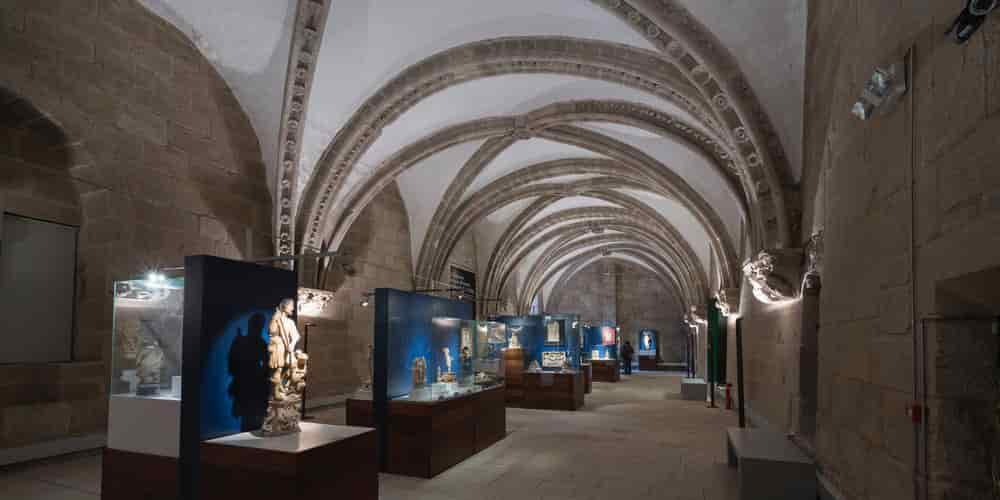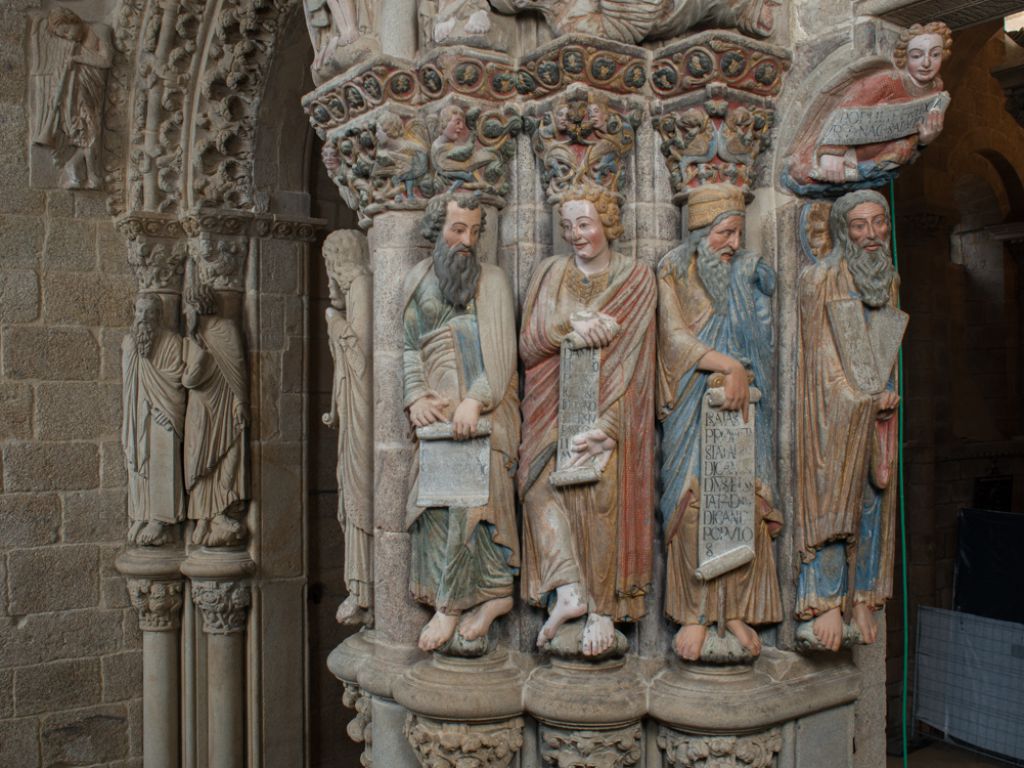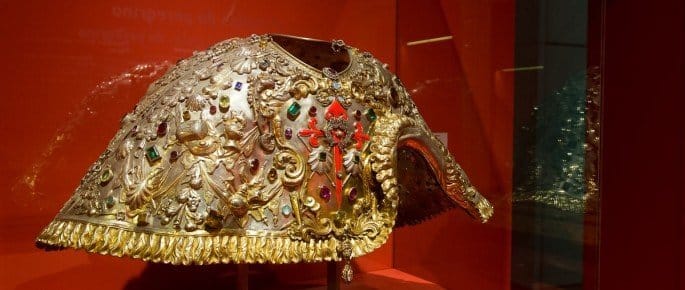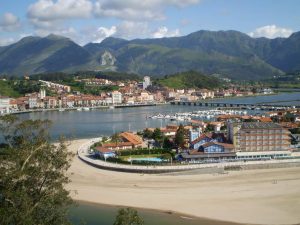History Cathedral of Santiago de Compostela began around the year 830, of the modern era, at the time that the remains of the Apostle Santiago, on Mount Libredón (Iria Flavia), a town near the current Santiago de Compostela. These remains were, in the first instance, deposited in a Roman necropolis from the XNUMXst century.
Índice de contenidos
- 1 ORIGIN WHEN WAS THE CATHEDRAL OF SANTIAGO DE COMPOSTELA BUILT?
- 2 WHO BUILT THE CATHEDRAL OF SANTIAGO DE COMPOSTELA?
- 3 DESTRUCTION OF THE PERCURSING CATHEDRAL OF SANTIAGO DE COMPOSTELA
- 4 DESCRIPTION OF THE ELEMENTS OF THE CATHEDRAL OF SANTIAGO DE COMPOSTELA
- 5 GELMIREZ PALACE
- 6 FACE WASHING OF THE CATHEDRAL AND PORTICO DE LA GLORIA
- 7 TREASURE OF THE CATHEDRAL OF SANTIAGO
- 8 CAPITULAR ARCHIVE
ORIGIN WHEN WAS THE CATHEDRAL OF SANTIAGO DE COMPOSTELA BUILT?
The knowledge of this fact caused that, around the remains of the Apostle, numerous people were congregating and, therefore, the need for the construction of a primitive pre-Romanesque Church, to welcome believers and Christian pilgrims.
Given the importance of the discovery, in the year 834, it became an episcopal seat, an issue that increased the number of people and pilgrims, favoring its social, economic and religious expansion, when the first religious monastic orders settled in it, they were times of Alfonso II, the Chaste, the first pilgrim to visit the remains of the Apostle, visiting what is now the Primitive Way, from the city of Oviedo. Over the centuries the main Camino de Santiago itineraries with pilgrims from all corners of Europe. As of the XNUMXst century and particularly in the first decade, the Trips to the Camino de Santiago organized They become one more option to be able to enjoy this thousand-year-old pilgrimage route, with the services and guarantees of professionals who provide us with greater peace of mind and comfort during the journey.
WHO BUILT THE CATHEDRAL OF SANTIAGO DE COMPOSTELA?
In the 872 King Alfonso III, the Great, ordered the construction of a larger temple. This would mean the base of the future Cathedral of Santiago.
DESTRUCTION OF THE PERCURSING CATHEDRAL OF SANTIAGO DE COMPOSTELA
Later, in 997, the Cathedral and Santiago de Compostela were burned and looted, at the hands of the Muslim caudillo Almanzor, including the transfer, by Christian captives, of the cathedral bells to Córdoba. There are various versions found, in which it is questioned whether the tomb where the Apostle’s remains were deposited was respected. Due to this fact, the cathedral was rebuilt in 1003, when San Pedro de Mezonzo was bishop.

IMPELLERS OF THE CATHEDRAL OF SANTIAGO DE COMPOSTELA
It was in the year 1075, with the construction of the Chapel of the Savior, when the foundations of a great Romanesque Church were actually laid and that with the passage of time it was expanded with different architectural styles, especially Gothic and Renaissance, until what we see today reflected in the current Cathedral of Santiago de Compostela. The promoters of this fabulous construction were King Alfonso VI and, particularly, the Bishop of Santiago Diego Peláez.
It would be built with a latin cross plant, with three naves, of an approximate length of 100 meters, with a transept of three naves, 67 meters in length, being the height of its central vault of 32 meters. Being built, fundamentally, of granite.
Given the huge mass of pilgrims who, year after year, visited the tomb of the apostle, they considered it essential to create a great “Pilgrimage Cathedral”, following the rules established by the French Romanesque, with the Cathedral of Saint Sernin in Toulouse as a mirror.
After different vicissitudes, logical in a construction of such magnitude, in the year 1093 a fundamental event took place with the appointment, as administrator of the cathedral, of the Archbishop Diego Gelmírez who was the great promoter of the cathedral and the city of Santiago de Compostela, making them a universal focus of Christianity and equaling the social phenomenon of pilgrimage, along with Rome and Jerusalem.
In its beginnings, master builders such as Bernardo el Mayor, his assistant Galperinus Robertus, Maestro Estevo, as well as a huge number of stonemasons, craftsmen and workers specialized in all the arts worked in the construction of the cathedral.

MASTER MATEO
To give a final boost to the works of the Cathedral, which had slowed down, King Leonés Fernando II, assigned the direction of the same to Master Mateo, between the years 1168 and 1211, his most important universal work being the construction of the Pórtico de la Gloria, inspired by the apocalypse of San Juan, jewel of the Spanish Romanesque. This sculptor is considered the “Sculptor of the Camino de Santiago”, well because of the numerous works he did in the French Way or by the disciples who had worked with him.
As cited in the Calíxtino Codex, the works of the Cathedral of Santiago de Compostela could be completed between the years 1122 and 1124, some 47 years after they started.
In the year 1120, Pope Calixto granted Santiago de Compostela the status of archiepiscopal see, with the consequent economic and power privileges that it entailed.
In 1181, the “forgiveness of sins” was granted to all pilgrims who visit the remains of the Apostle Santiago in a Jubilee Year (when the feast of Santiago – July 25 – fell on Sunday). The next Holy Year is the Jacobean 2021 which will last until the end of 2022 by papal order, due to the Covid pandemic.
The consecration of the Cathedral of Santiago de Compostela took place on April 21, 1211, with King Alfonso IX and Archbishop of Santiago D. Pedro Muñiz.
ENLARGEMENT AND REFORM
During the XNUMXth and XNUMXth centuries, profound transformations were carried out in the cathedral, introducing different baroque elements, both inside and outside the basilica.
The greatest aesthetic revolution would come to the temple in Baroque times, transforming the Main Altar and the dome, as well as the work carried out on the Clock Tower and with the projection of the facade of the Plaza de la Quintana. But it is, without a doubt, the facade of the Obradoiro the work that will most influence the definitely baroque appearance of the Santiago Cathedral on the outside.
DESCRIPTION OF THE ELEMENTS OF THE CATHEDRAL OF SANTIAGO DE COMPOSTELA
TORRES
The Cathedral has three towers. Two, which are twins (Torre de la Carraca, and Torre de las Campanas or Torre Norte), located on the main facade, in the Plaza del Obradoiro, with a height of 75/80 meters each and the other, located between the Platerías de Platerías and Plaza de la Quintana, called Torre del Reloj, “Berenguela” or also known as “Trinidad”.
La Carraca Tower o North Tower, as its name indicates, has a “ratchet” mechanism made of chestnut wood, which consists of four rectangular resonance boxes with a reed on each one that when rotating on a toothed axis and hitting them makes them sound; the boxes are arranged in the shape of a cross and each arm measures just over two meters. This piece is a replica, of the original, which is in the Cathedral Museum.

As its name suggests, the Bell tower, houses a set of 7 monumental bells, in addition to the bell, made up of seven other smaller bells, which have been recovered after the restoration of the Cathedral. This tower has the important peculiarity and it is that it is slightly inclined, so when you go to Santiago, look to check it.
La Clock Tower, Also known as “Berenguela” or “Trinidad”, is one of the best known elements of the Cathedral of Santiago de Compostela. It was built as a defensive tower, framed in the whole of the Cathedral, having a height of 72 meters.
It has a clock with a white marble dial, a single needle and two bells, which are not the originals. The original bell, with a diameter of 3 meters, dates from 1738 and is located in the cloister of the Cathedral.
As a significant element of it, the tower closes one “Lantern”, that with its permanent light guides the pilgrims in the Holy Years.

FACADES OF THE CATHEDRAL OF SANTIAGO DE COMPOSTELA
OBRADOIRO (WORKSHOP IN GALICIAN)
Its name comes from the presence of stonemason workshops that during the construction of the Cathedral were located at the foot of the Cathedral.
The original Romanesque façade was replaced due to
its deterioration over the centuries and constant repairs have taken place until it was completed in 2020.
In 1606, Master Ginés Martinez built the characteristic double staircase leading to the Cathedral of Santiago.
The facade and Plaza del Obradoiro represents the universal and most significant symbol of the city of Santiago, its most important elements being the two magnificent towers and the images of Santiago Peregrino.

JET
The façade of Azabachería, or North Facade is located in the Plaza de la Inmaculada or de la Azabachería, where the last urban section of the French Way ends, Northern Way, and finally from English Way with its entry through the ancient gate of Paradise.
It takes its name due to the presence of jet artisans who were in it.
The old Romanesque façade from the 1757th century was demolished in XNUMX and replaced by the current one, in the neoclassical style, under the supervision of Ventura Rodriguez.
TO QUINTANA
The Façade of La Quintana, in the Baroque style, began in 1658. In it the Puerta Real where the royals accessed, the Abbots gate, and in the middle of both the well-known Puerta Santa or Puerta del Perdón, which opens exclusively in Holy Year.
On this door you can see, in some niches, the image of Santiago and his disciples Athanasius and Teodoro who are at his sides. Twenty-four figures of prophets and apostles were placed in the lower body and on both sides of the door (including that of Santiago himself) that came from the old stone choir, which was located inside the Cathedral, built by Master Mateo
The Plaza de la Quintana is, after Obradoiro, the most emblematic square in Compostela. Monumental stone staircases divide it into two: Quintana de Vivos, the upper part, and Quintana de Mortos, the lower part because it was, in the past, a burial place.

PLATTERIES
Named for the number of artisans and goldsmiths dedicated to the work of silverware that were located in this place and that, still, do so today.
The Façade of Platerías is the only one in Romanesque style that the Cathedral of Santiago de Compostela has preserved. Built by Master Mateo between 1103 and 1117, with the driving help of the first Archbishop of Santiago de Compostela, Diego Gelmirez.
Composed of a double door with semicircular arches with an upper frieze. The second level of the façade is made up of two windows with lobed arches, where we highlight the figure of King David playing the harp, reliefs from Genesis, the sacrifice of Isaac and the adulterous woman. It is completed with other elements and sculptures from other parts of the Cathedral that ended up here moved by the constant reforms of the Cathedral.
To the left of the façade, we find the Treasury building, in a Renaissance style and whose construction was directed by the architect Gil de Hontañón.
ROOFS OF THE CATHEDRAL OF SANTIAGO DE COMPOSTELA
At almost 300 meters of altitude, 30 meters above the Plaza del Obradoiro and with a 360-degree field of vision, the gaze slides across the rooftops and is lost in the Compostela landscape.
In addition to the views of towers, domes and landscape that can be seen from their heights, one of the best known elements of the roofs is the so-called “Cruz dos farrapos”, which means “Cross of rags”. Tradition says that here, after sleeping in the stands, the pilgrims they left their old clothes to be burned in the small space behind the cross, as a symbol of purification and the beginning of a “new life”.
This legend of the Cross two farrapos undoubtedly inspired those who today burn their clothes after making the Way to Finisterre.
There is a record of the visits that the pilgrims had, from the roofs, in the Calixtino Codex: “Whoever goes up there (…) even if he goes up sad is happy to see the splendid beauty of this temple”.

GELMIREZ PALACE
Leaning on the north side of the Cathedral, and towards the Plaza do Obradoiro, this Episcopal Palace rises, ordered to be built by Archbishop Diego Xelmírez to replace the old episcopal residence demolished during the numerous revolts that occurred during his episcopal mandate.
The building, with access to two squares (Obradoiro and Azabacheria), would become an accommodation to receive the kings, princes and nobles who visited the city.
It is considered one of the main Romanesque civil constructions in Spain and the center of feudal power exercised by the bishops of Santiago.

FACE WASHING OF THE CATHEDRAL AND PORTICO DE LA GLORIA
In recent years a thorough facelift has been carried out to eliminate the “blackish” color and even the moss that was already coming out of some of the stones of the Cathedral of Santiago.
All with the aim of an arduous restoration program so that the entire Cathedral wore its best clothes in the next Jacobean Year 2021 and whose works will continue until then.
With a cost of about 17 million euros, the works in the Cathedral of Santiago de Compostela include not only the aforementioned façade of the Plaza del Obradoiro and the famous Pórtico de la Gloria, but also the rehabilitation of the façade of the Plaza Quintana, the cleaning of the Clock Tower and those of Xelmírez and Abades, as well as roofs, the restoration of the Portico and the interior rehabilitation of the basilica.
TREASURE OF THE CATHEDRAL OF SANTIAGO
At Lóleo Eventos, Chapel of San Fernando, which today is part of the itinerary of the Cathedral Museum, is located the so-called “Treasure”, which includes the richest pieces of liturgical goldsmith, among them, the Processional custody performed by Antonio Arfe.
Inside we can find, as the most outstanding pieces:
La original cape of Santiago el Mayor, made in the year 1704 – Relief of the Virgin of the Milk by Luisa Roldán – Reliquary bust of Santiago el Menor, who wears the bracelet of D. Suero de Quiñones on his neck, which he won in the famous gentlemen’s joust, which took place in the Paso Honroso, in the León town of Hospital de Órbigo, in the year 1434
The safe in the room contains a Chalice and Vinajera donated by Archbishop Musquiz, a Custody of Juan de Figueroa, a Chalice of Pose and a large ruby.

CAPITULAR ARCHIVE
The Cathedral Archive of the Cathedral of
Santiago de Compostela guards documen










